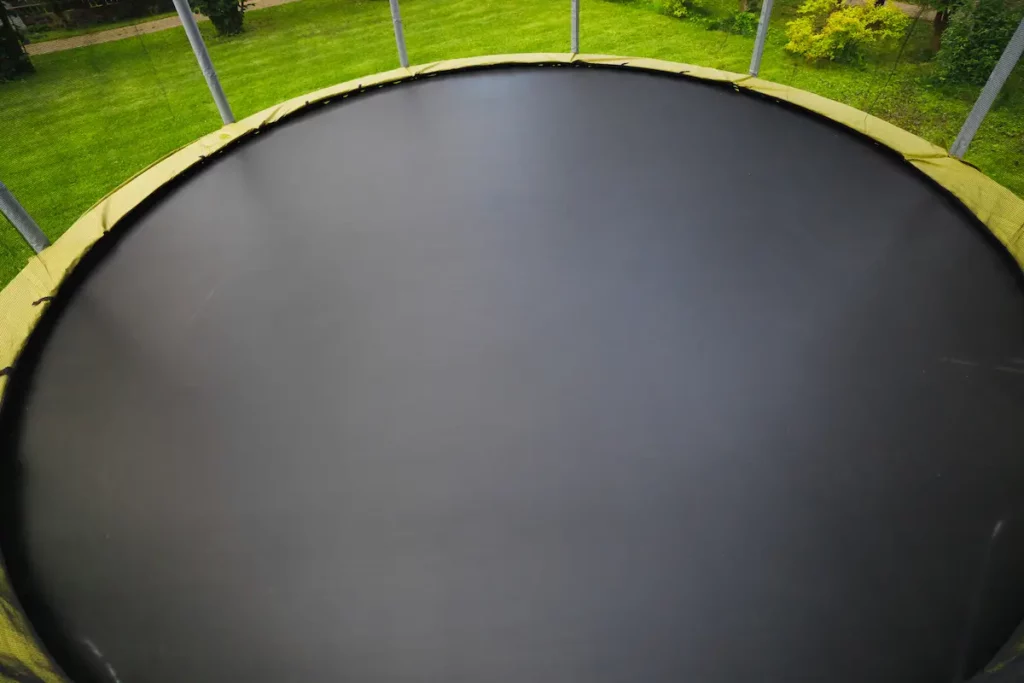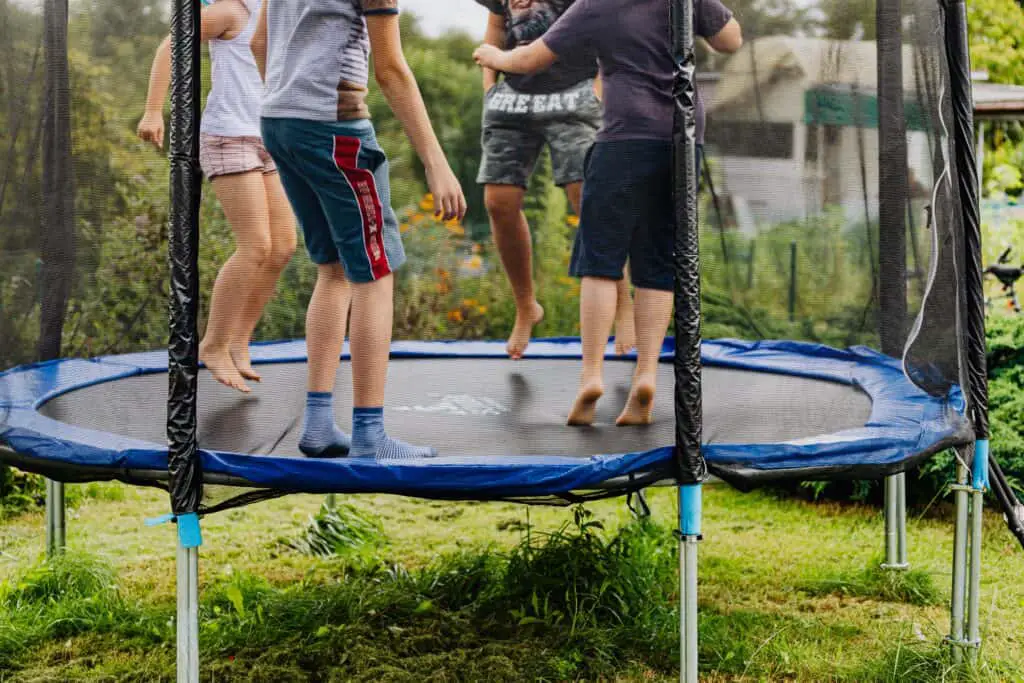Trampoline mats are often made black as black is the colour that degrades the least in the sun by absorbing UV radiation before it reaches the plastic. Other colours would also show the accumulated dirt through continuous use much too easily.
Anyone who owns a trampoline can attest to how hot the big, black mats which carry the springs can get, and the horrible black colour it stains your feet once you had it for a while. It has led some to wonder: why are trampoline mats black?
So many people have questioned whether black is truly the best colour for trampoline mats to be considering some of the issues that they have been known to have. To understand why the makers of trampolines have designed modern mats the way they do, we should indulge in a little history.

Related Reading: How Much Do Trampolines Weigh? Comparing 36 Different Models
Trampoline History
Even before trampolines, humans have seemed to have a strange fascination with the concept of jumping from high and ‘rebounding’ onto a piece of fabric. In early Europe, for example, it was considered a form of entertainment for one person to jump from on high into a piece of fabric held by some others, and to then be thrown back up into the air.
But the invention of what we can now call a ‘trampoline’ came from the mind of George Nissen in 1934. Inspired by seeing a trapeze artist bouncing on the safety net below them after they performed their tricks, George wondered about inventing a device where bouncing off it to perform tricks was the entire point. So that’s what he did.
Early Trampoline Design
The first trampoline design was not much more than a piece of canvas stretched across a rectangular frame with coiled springs on it. At first, it was used to train tumblers and American pilots in World War 2, but by 1942, it had gone commercial for recreational use.
Canvas was found to be less durable than nylon, so it was soon replaced with nylon webbing, and padding was added around the springs to protect jumpers from landing on them when they fell, and nets were added after that to stop them from falling off altogether.
You might be beginning to recognize the shape of our modern trampolines from this description – and whilst the basic shape of the trampoline has stayed more or less consistent from this. Since then, the design has been consistent, but some highlights of trampoline history are:
- In 1938, a man named Ed Russell invented the first mini trampoline, which, whilst not patented until 1975, is still used as part of physical and exercise therapy.
- Early hype around trampolines led to the creation of many trampoline parks in 1959 and 1960 in the US, although the parks had high accident rates.
- Trampoline parks then experienced a second wave in 2011, with new and improved designs making them safer than ever.
Modern Trampolines
Modern trampolines have mostly kept the same basic design from the early days of trampolining, although in recreational home use, where large rectangle trampolines used to be the default choice, now the round trampolines are more likely to be found in the back garden. This is for several safety reasons: first, the round shape is more naturally secure than the rectangle one, and second, being round, it guides jumpers into the center, which is the safest place to be.
The trampoline mat is generally made from waterproof canvas or woven polypropylene. These materials are elastic and durable and woven into a mesh for extra strength. They are generally waterproof but can be damaged by the elements over time – by UV slowly breaking down its fibers, and water getting in once it is already damaged.
The coil springs from the early days of trampolining are still present, but nowadays, there are alternatives to the springs if jumping too close to snapping springs makes you in any way uncomfortable.
You may be interested in: Interesting Ways to Recycle Trampolines
How Important Are The Trampoline Mats?
So, we’ve established trampoline history and design, and we’ve seen that the mat has been one of the biggest things to change since George Nissen discovered that it might be fun to put a stretchy piece of fabric on a frame to jump around on. From canvas to nylon, to polypropylene – ironically back to canvas and nylon in different forms, we’ve seen the design of the mats jump all over the place.
This is because, in terms of trampolining, the mat is what you need to get right. That is why even the colour of the things is too important to take a chance on, and why you don’t go looking for trampolines for your home and find the mats in many kinds of wacky colours. Needless to say, mat care is one of the most important things when it comes to maintaining your trampoline.

Trampoline Mat Care
This could fill up an article in itself, but there are some tips that could be taken to ensure that the trampoline you just built lasts as long as possible:
- Do your research before buying one. Some act as if trampolines are one size fits, but it is anything but. Make sure you have the right one – different trampolines have different factors they excel and are weak, and some sellers offer spare parts and warranties. Doing a little research can save a lot of headaches later.
- Check for issues every week at the minimum. Most large issues have much smaller warning signs which can be spotted ahead of time.
- Squeaky springs are not necessarily a sign of anything damaged or terrible – a little WD40 can fix it right up
- If the trampoline mat has holes in it, it is completely possible to patch it up with either adhesive or needle and thread – it’s not necessary to buy a new one. With that being said, if you’re uncomfortable, doing the job, then buying a new one may be safer. It’s your choice.
- The mat edging will be more affected by UV radiation if there is no padding on the sides, so make sure to replace the padding if it becomes old and frayed.
- If you’re getting black stuff on you from the mat, then that may simply be a sign it needs to be cleaned from accumulated grime, or it could be that the trampoline mat is getting old and carbon ingredients are coming through from the weaving. Give it a good clean, and if you’re still black after touching it, then replace the trampoline mat.
- Trampolines, with their black mats and metal springs, can get very warm in the sun due to the mat absorbing sunlight and the metal springs conducting them easily. Your trampoline will be much cooler, as well as last longer, if you put it into a shady area, or failing that, set up a shade over the top of it yourself.
Related Reading: Most Common Trampoline Injuries (+ Safety Tips)
Conclusion
Trampoline mats are black because of a long history of design trial and error. After first being made from canvas and then nylon, it was found that the color black is the most durable against UV radiation.
Modern trampolines are made from waterproof canvas or woven polypropylene for their strength, elasticity, and durability against all manner of exposure.
Although the peak of trampoline design, they are still subject to some problems, such as carbon ingredients leaching out when they get older and still getting overly warm in the sun, these problems can be dealt with accordingly by people.

